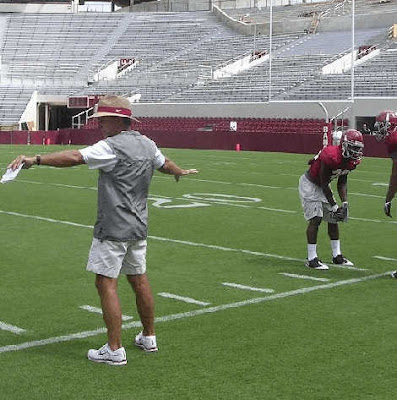All the material covered in these posts can be found in the Holy Grail of Defense, the 2001 LSU Defensive playbook. The 2001 LSU Playbook can be accessed here;
http://0101.netclime.net/1_5/261/2ce/3a9/LSU_Defense_2001.pdf
and if the link dies, the file is located here;
http://sitekreator.com/brophyfootball6/main_page.html
When you get down to it, there are really only two types of coverages in Saban's world;
- middle of the field safety
- split-safety coverage
- man to man
- zone
- pattern match (after pattern distribution)
In the subsequent posts, we'll look at the various types of coverages Saban employs, and the fundamental elements that make them work.
Of the most noteable elements to his instruction to defensive backs is what he calls "position maintenance". This is a defenders leverage on a receiver in relation to his position with the field and other defenders.
Divide And Conquer
The first thing Saban will teach his defensive backs is understanding their "divider". The divider simply divides the field in relation to the deep safety to the split receiver. More can be read/watched about the divider here. The divider exists 1 yard inside the top of the numbers on the field. These numbers are 2 yards tall, so the 'top' exists at 9 yards from the sideline, and the 'bottom' exists at 7 yards from the sideline. The defensive back uses the divider to position himself to either cut off or funnel the receiver to his deep safety help. According to Saban, to be a good defense, you HAVE to be able to take away the middle of the field. This forces an offense to throw it short and in the flat.
As the distance from the sideline to the hash is 17.8 yards, the divider essentially cuts the 1/3rd of the field in half to put the defensive back in the best possible position to discourage/leverage throws.
Position Maintenance
Once the defensive back aligns properly, he moves on to "position maintenance". Using the divider as a rule, extending all the way down the field, once the receiver stems into his route the defender must maintain his divider leverage on the receiver.
If the receiver stems outside with the corner already aligned outside, the corner should be inside the receiver (as the receiver extends the distance between himself and the safety). Conversely, if stems inside, the corner should maintain his horizontal position of outside leverage.
The next phase of position maintenance involves their horizontal and vertical adjustments relative to the coverage.
When a receiver stems outside, the zone defender can turn his butt outside because he ends up in a half-turn with his eyes in a position to see the receiver and quarterback. When you turn your hips/butt inside (away from the ball), you no longer are looking at the ball. To adjust to this, Saban has his defensive backs shuffle / slide inside with a heel-to-toe 'waltz'. The only thing that can hurt the defender now, is when the recevier disappears while he's in a half-turn (drop out / bench route). The defender cannot turn back in and chase (from a backpedal, plant, and drive) - this would take too long and he would lose the receiver. The defender should 'roll' into the receiver (open to the sideline). This particular technique was highlighted recently in an Alabama press conference after a game against FIU and Rusty Smith.
The divider rules stay consistent in zone coverage, but what about when it is man-free (C1), what changes for the defensive back? The vertical position on the receiver.
When the receiver stems inside the divider in C1, the corner has deep help inside, therefore the corner can maintain a 'low-shoulder' (trail) position on the receiver. The rationale is, if there is safety help, there is no need to stay high on a receiver. The only route left for the corner to defend is the "corner" route, so the defensive back is in perfect position to cut off this throw. If a defensive back has help inside, he is going to play outside leverage and low-shoulder.
Conversely, if the receiver stems outside, the corner's position should be inside and high. By maintaining a 'high-shoulder' position on a receiver, the defensive back can control the speed of the receiver with the outside arm/hand while he cuts off the inside throw. The principle is the same no matter the coverage.
This all plays into what Saban defines as being "in phase" with a receiver (which essentially is the position of being close enough to touch the receiver) and gives the defensive back a guideline on how to play the ball based on his vertical position. When a corner is "high-shoulder" leverage, he is "in-phase" with the receiver, putting him in position to be a receiver to play the ball.
When a corner is "out-of-phase" (i.e. low-shoulder with no help) he cannot look for the ball (he is not in a position to be a receiver) and must play the ball through the reception (catch up to receiver and discourage the completion).
In the next few posts, we will take a look at how Saban teaches Cover 3 and Cover 1 and why he prefers middle of the field safety coverage.
















No comments: